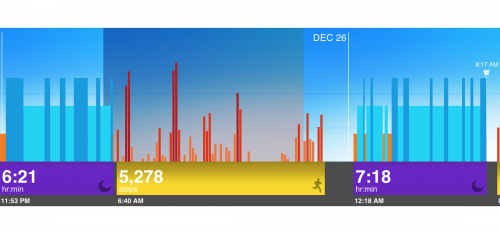 click > enlarge
click > enlarge
Jawbone doesn’t say “I quit” with their activty-tracking wristband they launched a year ago. The UP had all kinds of technical problems, enough so that a formal refund policy program was put into place. Jawbone promises after a great deal of research and testing that the second generation UP will stay up.


[ new ] Generation two is more waterproof, one of the reasons why the first band couldn’t hold a battery charge. There’s a much-improved mobile software that offers more comprehensive data-tracking experience. You now have a Trends tab that allows side-by-side comparisons of personal metrics. When in a mood there’s a Moods tab and more detailed food logging, with a bar-code scanner for scanning food items.


[ features ] Up tracks your motion using the same MotionX technology found in the Nike+ package. It can track your steps, for everyday walking, or it can watch your route via GPS if you’re a runner. The app will tell you your steps, distance, calories, pace, and intensity level among other information. During the day, you can set the wristband to vibrate on your wrist to give you a reminder to move around if you’ve been inactive for too long.
The wristband also serves as a comprehensive sleep tracking product much like the popular Sleep Cycle apps available on the App Store. Putting the wristband in Sleep Mode will automatically track the hours you slept, what stages you were in, what time you were awake, and it’ll score your overall sleep quality. Like the iPhone sleep apps, Up will wake you up when it thinks the time is best, but it cleverly uses the vibration feature from before to wake you up quietly. [ jawbone ]
 click > enlarge
click > enlarge
By now we’ve probably all seen the catchy videos promoting Nike’s new fitness tracker, NikeFuel. But exactly how is it different from their previous system, and how does it actually work?
Before NikeFuel there was the sensor you inserted in the bottom of your shoes. It kept track of your steps and synced that information to your iPhone or iPod. When I first started running more seriously I used this system, but I found that my distance was always a half mile off from what the treadmill read or what Google Maps told me was, for example, a three mile route. The feature to customize your sensor to your specific footfalls never worked and it oftentimes dropped data so I couldn’t track my progress online.
The NikeFuel band also communicates your training to your Apple devices, but it just seems like a fancy, $150 pedometer. It doesn’t track your heart rate, but the real advantage here is that it tracks all the activity you do, whether it’s swimming laps, running, training in the gym, walking up a flight of stairs or dancing. The thing is, Nike doesn’t tell you how it does this, which makes me think it’s going to be just as off-base in its tracking as the sensor was. You can’t input personal data like sex or weight, so how accurate can it really be? It’s common knowledge that an overweight man is going to burn energy at a different rate than a petite woman, yet their activity is tracked in the same way.
For starters, I’d really love to know how the accelerometer works – how does it the translate the energy expended in skateboarding down a street? What Nike does push are all the bells and whistles, its bluetooth technology, its built-in motivational color system (your band changes from red to green depending on how much activity you’ve completed) and its overall fun factor: life isn’t just boring old life anymore, it’s a sport. But if you don’t buy this wrist band you’ll never know how much sporty fun you’re missing out on.

about perrin drumm
 click > enlarge
click > enlarge







